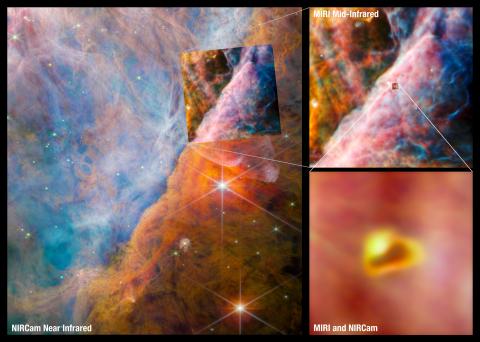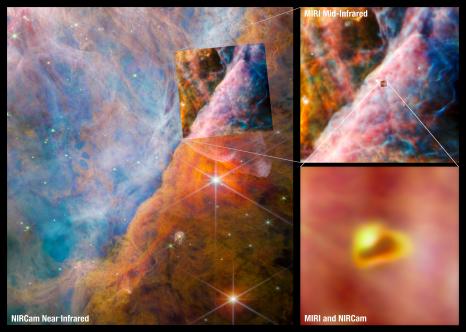
A new carbon molecule detected by the James Webb Space Telescope
An international team of scientists, including experts from laboratories at Université Paris-Saclay, have used data collected by the NASA/ESA/CSA James Webb Space Telescope (JWST), with key input from laboratory spectroscopists, to detect a molecule known as the methyl cation (CH3+) for the first time, located in the protoplanetary disc surrounding a young star, in the Orion Nebula approximately 1,300 light years away from Earth. Researchers working at the Institut d'Astrophysique Spatiale (IAS – CNRS, Université Paris-Saclay) and the Institut des Sciences Moléculaires d’Orsay (ISMO – CNRS, Université Paris-Saclay) were heavily involved in this exciting discovery.
This simple molecule has a unique property: it reacts relatively inefficiently with the most abundant element in our Universe (hydrogen) but reacts readily with other molecules and therefore initiates the growth of more complex carbon-based molecules. Carbon chemistry is of particular interest to astronomers because all known life is carbon-based. The vital role of CH3+ in interstellar carbon chemistry was predicted in the 1970s, but Webb’s unique capabilities have finally made observing it possible — in a region of space where planets capable of accommodating life could eventually form.
Researchers at ISMO were heavily involved in the spectroscopic analysis of the lines emitted towards the protoplanetary disc which were observed by JWST. Using existing low-resolution laboratory data on CH3+, ISMO developed a spectroscopic model of the transitions involving CH3+. This model was then discussed and reviewed with a scientific team from the University of Cologne. Thanks to this model, it was possible to validate the identification of CH3+ in JWST astrophysical observations. The model also demonstrates potential prospects and the need to acquire specific measurements from laboratory astrophysics for the detection of key molecular species in astrophysical environments.
This work was carried out as part of the project, PDRs4All (Photodissociation Regions for All), - one of 13 ‘Early Release Science’ JWST programmes, coordinated by three co-PIs, including Emilie Habart, Lecturer at Université Paris-Saclay and researcher at IAS (Univ. Paris-Saclay/CNRS), Olivier Berné, CNRS Astrophysicist at the Toulouse Research Institute for Astrophysics and Planetology (IRAP- CNRS/Univ. Toulouse III Paul Sabatier/CNES/Observatoire Midi-Pyrénées) and Els Peeters, Professor at the University of Western Ontario (Canada). These observations are designed to showcase JWST's observational capabilities and show the astronomical community how to take full advantage of its instruments. The team behind this JWST programme has already planned other observations. The reduction of the JWST/MIRI-MRS data, the instrument which made the detection of the CH3+ molecule possible, was carried out at the French MIRI centre of expertise with the support of the French national space agency, CNES, and the Innovative Common Laboratory for Space Spectroscopy (INCLASS), between the IAS and ACRI-ST.
Contacts for Université Paris-Saclay
Emilie Habart, Institut d'Astrophysique Spatiale (IAS- Univ. Paris-Saclay / CNRS) emilie.habart@universite-paris-saclay.fr
Marie-Aline Martin, Institut des Sciences Moléculaires d’Orsay (ISMO-Univ. Paris-Saclay / CNRS) marie-aline.martin@universite-paris-saclay.fr
Emmanuel Dartois, Institut des Sciences Moléculaires d’Orsay (ISMO-Univ. Paris-Saclay / CNRS) emmanuel.dartois@universite-paris-saclay.fr

